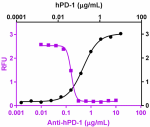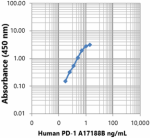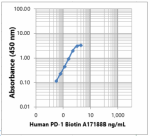- Clone
- A17188B (See other available formats)
- Regulatory Status
- RUO
- Other Names
- PD1, PDCD1
- Isotype
- Mouse IgG2b, κ
- Barcode Sequence
- ACAATTCCTGTCACA
- Ave. Rating
- Submit a Review
- Product Citations
- publications
Programmed cell death protein 1 (PD-1), also known as CD279, is a 55 kD member of the immunoglobulin superfamily. CD279 contains the immunoreceptor tyrosine-based inhibitory motif (ITIM) in the cytoplasmic region and plays a key role in peripheral tolerance and autoimmune disease. CD279 is expressed predominantly on activated T cells, B cells, and myeloid cells. PD-L1 (B7-H1, CD274) and PD-L2 (B7-DC, CD273) are ligands of CD279 (PD-1) and are members of the B7 gene family. Evidence suggests overlapping functions for these two PD-1 ligands and their constitutive expression on some normal tissues and upregulation on activated antigen-presenting cells. Interaction of CD279 ligands results in inhibition of T cell proliferation and cytokine secretion.
Product DetailsProduct Details
- Verified Reactivity
- Human
- Antibody Type
- Monoclonal
- Host Species
- Mouse
- Immunogen
- Recombinant human CD279 protein
- Formulation
- Phosphate-buffered solution, pH 7.2, containing 0.09% sodium azide and EDTA
- Preparation
- The antibody was purified by chromatography and conjugated with TotalSeq™-D oligomer under optimal conditions.
- Concentration
- 0.5 mg/mL
- Storage & Handling
- The antibody solution should be stored undiluted between 2°C and 8°C. Do not freeze.
- Application
-
PG - Quality tested
- Recommended Usage
-
Each lot of this antibody is quality control tested by immunofluorescent staining with flow cytometric analysis and the oligomer sequence is confirmed by sequencing. TotalSeq™-D antibodies are compatible with Mission Bio’s Tapestri Single-Cell Sequencing Platform for simultaneous detection of DNA and Protein.
To maximize performance, it is strongly recommended that the reagent be titrated for each application, and that you centrifuge the antibody dilution before adding to the cells at 14,000xg at 2 - 8°C for 10 minutes. Carefully pipette out the liquid avoiding the bottom of the tube and add to the cell suspension. For Proteogenomics analysis, the suggested starting amount of this reagent for titration is ≤ 1.0 µg per million cells in 100 µL volume. Refer to the corresponding TotalSeq™ protocol for specific staining instructions.
Buyer is solely responsible for determining whether Buyer has all intellectual property rights that are necessary for Buyer's intended uses of the BioLegend TotalSeq™ products. For example, for any technology platform Buyer uses with TotalSeq™, it is Buyer's sole responsibility to determine whether it has all necessary third party intellectual property rights to use that platform and TotalSeq™ with that platform. - Application Notes
-
A17188B antibody can block the binding of NAT105 and EH12.2H7 antibodies to the target.
- Additional Product Notes
-
TotalSeq™-D reagents are designed to profile protein expression at single cell level. The Mission Bio Tapestri platform and sequencer (e.g. Illumina analyzers) are required. Please contact technical support for more information, or visit biolegend.com/totalseq/single-cell-dna
The barcode flanking sequences are CGAGATGACTACGCTACTCATGG (PCR handle), and GAGCCGATCTAGTATCTCAGT*C*G (capture sequence). * indicates a phosphorothioated bond, to prevent nuclease degradation.
View more applications data for this product in our Application Technical Notes. - RRID
-
AB_2892479 (BioLegend Cat. No. 621617)
Antigen Details
- Structure
- 55 kD type I transmembrane protein
- Distribution
-
Transiently expressed on CD4- and CD8- thymocytes, upregulated in thymocytes and splenic T and B lymphocytes, and is expressed on activated myeloid cells.
- Function
- Signaling and co-stimulation (co-inhibition)
- Interaction
- SHP-1 and SHP-2
- Ligand/Receptor
- PD-L1 (CD274) and PD-L2 (CD273)
- Cell Type
- Lymphocytes, T cells
- Biology Area
- Cell Biology, Immuno-Oncology, Inhibitory Molecules
- Molecular Family
- CD Molecules
- Antigen References
-
- Ishida Y, et al. 1992. EMBO J. 11:3887
- Francisco LM, et al. 2010. Immunol Rev. 236:219
- Gene ID
- 5133 View all products for this Gene ID
- UniProt
- View information about CD279 on UniProt.org
Related FAQs
Other Formats
View All CD279 Reagents Request Custom Conjugation| Description | Clone | Applications |
|---|---|---|
| Ultra-LEAF™ Purified anti-human CD279 (PD-1) | A17188B | Block |
| Purified anti-human CD279 (PD-1) | A17188B | FC,Direct ELISA |
| PE anti-human CD279 (PD-1) | A17188B | FC |
| APC anti-human CD279 (PD-1) | A17188B | FC |
| FITC anti-human CD279 (PD-1) | A17188B | FC |
| PerCP/Cyanine5.5 anti-human CD279 (PD-1) | A17188B | FC |
| PE/Cyanine7 anti-human CD279 (PD-1) | A17188B | FC |
| TotalSeq™-D1169 anti-human CD279 (PD-1) | A17188B | PG |
| APC/Fire™ 810 anti-human CD279 (PD-1) | A17188B | FC |
| PE/Fire™ 640 anti-human CD279 (PD-1) | A17188B | FC |
| PE/Fire™ 700 anti-human CD279 (PD-1) | A17188B | FC |
| PE/Fire™ 810 anti-human CD279 (PD-1) | A17188B | FC |
| Biotin anti-human CD279 (PD-1) | A17188B | Direct ELISA |
| PE/Dazzle™ 594 anti-human CD279 (PD-1) | A17188B | FC |
| KIRAVIA Blue 520™ anti-human CD279 (PD-1) | A17188B | FC |
| Spark Red™ 718 anti-human CD279 (PD-1) | A17188B | FC |
Compare Data Across All Formats
This data display is provided for general comparisons between formats.
Your actual data may vary due to variations in samples, target cells, instruments and their settings, staining conditions, and other factors.
If you need assistance with selecting the best format contact our expert technical support team.
-
Ultra-LEAF™ Purified anti-human CD279 (PD-1)

Recombinant hPD-1 binds to hPD-L1. Anti-human PD-1 Antibody ... -
Purified anti-human CD279 (PD-1)

PHA-stimulated (3 days) human peripheral blood lymphocytes w... 
Direct ELISA showing purified anti-human PD-1 (clone A17188B... -
PE anti-human CD279 (PD-1)

PHA-stimulated (day-3) human peripheral blood lymphocytes we... -
APC anti-human CD279 (PD-1)

PHA-stimulated (day-3) human peripheral blood lymphocytes we... -
FITC anti-human CD279 (PD-1)

PHA-stimulated (day-3) human peripheral blood lymphocytes we... -
PerCP/Cyanine5.5 anti-human CD279 (PD-1)

PHA-stimulated (day-3) human peripheral blood lymphocytes we... -
PE/Cyanine7 anti-human CD279 (PD-1)

PHA-stimulated (day-3) human peripheral blood lymphocytes we... -
TotalSeq™-D1169 anti-human CD279 (PD-1)
-
APC/Fire™ 810 anti-human CD279 (PD-1)

PHA-stimulated (three days) human peripheral blood lymphocyt... -
PE/Fire™ 640 anti-human CD279 (PD-1)

PHA-stimulated (three days) human peripheral blood lymphocyt... -
PE/Fire™ 700 anti-human CD279 (PD-1)

PHA-stimulated (three days) human peripheral blood lymphocyt... -
PE/Fire™ 810 anti-human CD279 (PD-1)

PHA-stimulated (three days) human peripheral blood lymphocyt... -
Biotin anti-human CD279 (PD-1)

Direct ELISA showing biotin anti-human PD-1 (clone A17188B) ... -
PE/Dazzle™ 594 anti-human CD279 (PD-1)

PHA-stimulated (three days) human peripheral blood lymphocyt... -
KIRAVIA Blue 520™ anti-human CD279 (PD-1)

PHA-stimulated (three days) human peripheral blood lymphocyt... -
Spark Red™ 718 anti-human CD279 (PD-1)

Human peripheral blood lymphocytes were stained with anti-hu...













Follow Us